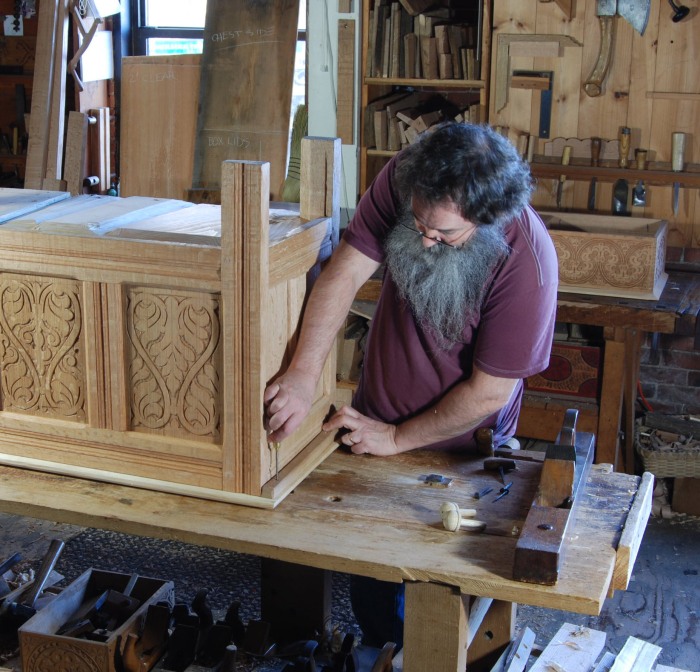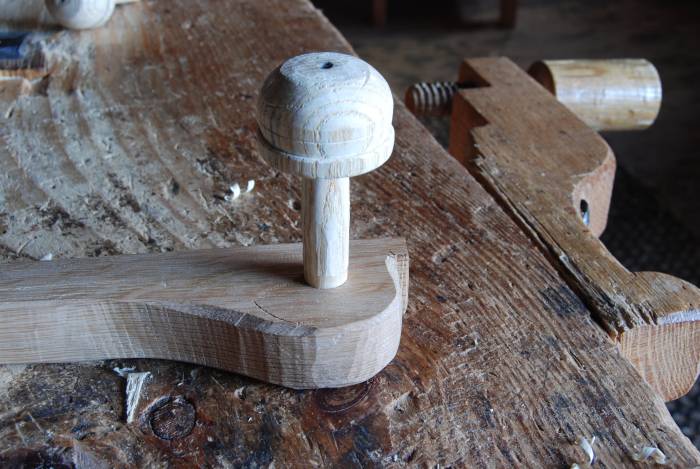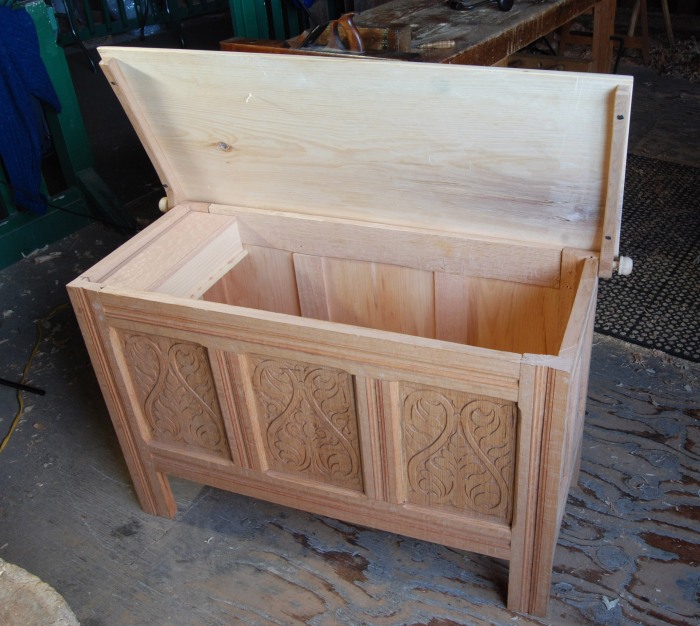Tool-selling is making me crazy. If you hi-hosied a tool, you will hear more from me early this week. I packed 20+ boxes today, with about that many more tomorrow. so hang in there.
Meanwhile, here I am, back to actual woodworking. I have made wooden hinges on many of my boxes over the years. I over-represent them based on 17th-century surviving examples, but people nowadays are drawn to the idea of a wooden hinge.
I have rarely used them on joined chests, but shot the process this week for the book I’m writing about chests. I might have mentioned them in the DVD but didn’t show one. So here goes.
First, here it is all done. The turned bit goes loosely through a hole bored in the enlarged end of the cleat. Then it fits tightly in a corresponding hole bored in the rear stile.
They require a bit of fussing. First, you need to plane or shave a rounded edge on the top rear rail’s outside arris. This is to allow the lid to slide by when it’s opening & closing. You can use a plane, or a spokeshave. I worked with both tools the other day. I start with a bevel then continue to round it over by eye. There will be some adjustments made when you test-fit the lid. I just tilted the chest up on its front feet, and jammed it against the bench to get at it.
I have made cleats to fit the lid, with an enlarged end at the back. This will have room for the hole bored in it, in this case I made the hole 9/16”. To bore pilot holes in the cleat, I clamp it in the double screw, to lessen the risk of splitting the cleat.
Then, I set the whole shebang upside down on the bench. Set the chest on the lid, check the amount of overhang this way & that, then set the cleats in place & mark the lid for the nails that fasten the cleats.
Then I nail the cleats to the lid, but don’t clinch them yet. Set the lid in place, mark where the holes go in the stiles. bore these.
I turned the pintles, and tested the fit in the hole in the cleat. I want the end of the pintle a very tight fit in the stile, but the part near the pintle’s head loose in the cleat…so more fussing this way & that.
Here, I am testing the pintle end in the hole. It burnishes a mark that shows me where to shave with a knife to get the fit I need. I don’t want it so tight it splits the stile or the cleat.
Then a test-fit with the turned pintles in place. Try the lid. Watch for any rubbing of the lid on the rear rail. Fine-tune this, making clearance for the lid to swing by. On & off with the lid. It’s annoying, but if the lid binds anywhere on the rear rail, it will get ruined in time. It’s tempting to say “good enough” – but anything less than totally cleared is not good enough…it has to be right.
Once I was satisfied, I took the lid back off, clinched the nails, then put it back & glued the pintles into the rear stiles.













I love your double screw. It looks like a miniature Moxon vise. I think I’ll make me one.
Why not glue the pintle to the cleat?
Is this because you want the wearing surface to be the cleat and pintle and not the pintle and stile? ( I can imagine a stretched hole in the stile is more difficult to repair than the removal of the guled pintle end)
It does seem like you have left some length to the pintle, so that it could be cut off at a future date and since the cleat is nailed, repairs are possible.
Have you ever seen an old pintel pin with a knob? Now I had a go-around with a certain cabinetmaker regarding shaping the rar rails and rear poss for both pintel and “snipe” hinges, and I suggested maybe the notches chopped in rear of Norman rear posts might have been a lid stop. This was greeted as stupid because “They always mounted snipe hinges at the rear edge of the lid. Well, can one set them in an inch or more on a lid so the lid overhung the back when opened? I guess it would hit the posts and keep wanting to fall forward. Given the roughness of some chests, I guess they just chopped the notch to get the rear posts out of the way> I should mention that the chest in question has the working face of the rear facade facing forward or in, so the posts are thicker than the rails and so forth.
[…] the bottom of the door for a smoother fit, it fit perfectly and pivots nice and smooth. I credit Peter Follansbee’s blog with the idea, though he uses these pegged hinges as lids for boxes. And HE got the idea from […]